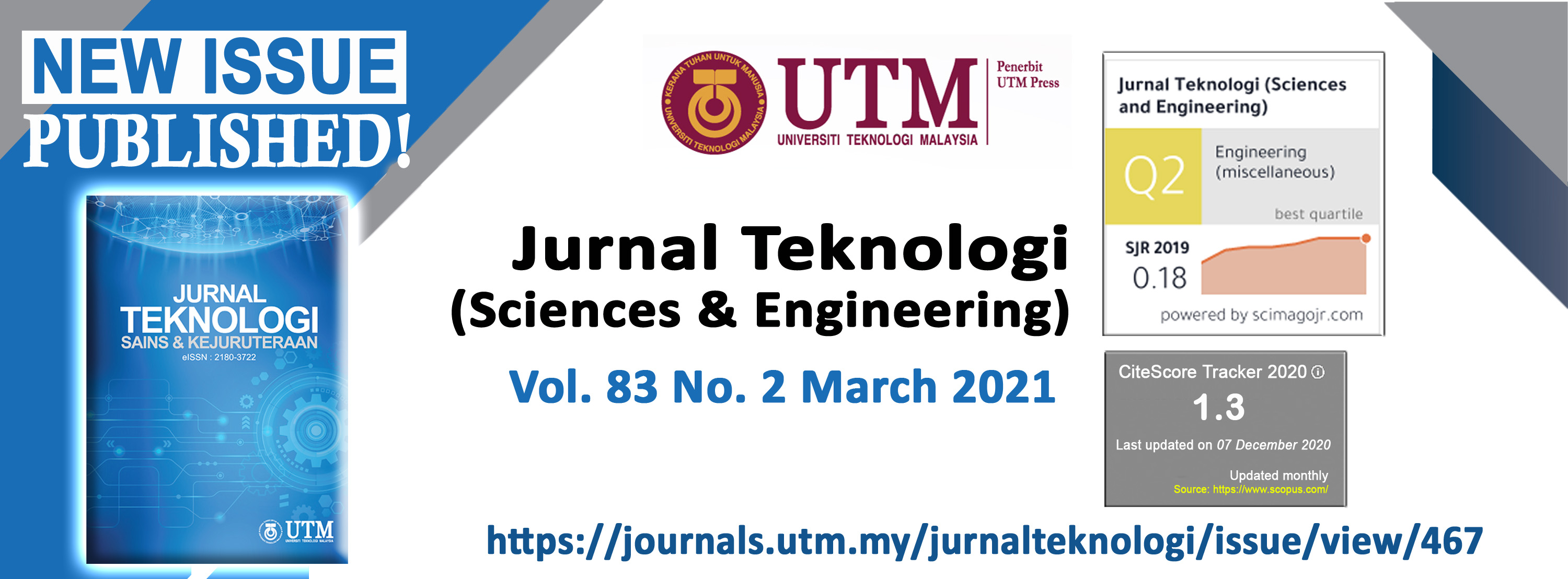INVESTIGATION ON DOWNSTREAM PROCESSING OF INDUSTRIAL SCALE OF FLEXIRUBIN PRODUCTION USING SUPERPRO DESIGNER
DOI:
https://doi.org/10.11113/jurnalteknologi.v83.14688Keywords:
Fermentation, SuperPro Designer, flexirubin, downstream processingAbstract
The aim of this work is to utilize a process simulator SuperPro Designer v5.5 (Intelligent, NJ, USA) for investigation on the most optimum scenario for the recovery of flexirubin pigment that was produced from a fermentation process using Chryseobacterium artocarpi strain. Process flow sheeting was based on the production of 300 kg per annum of flexirubin. Production phase at 1000 L bioreactor (including steps for the inoculum development) and different scenarios/routes for recovery of flexirubin were considered. SuperPro designer process simulator allowed for the computation of overall operating cost and capital cost under various operating parameters. Results from simulation shows that all proposed downstream processing routes is capable of achieving a high degree of flexirubin recovery yield i.e. at least 94% (or greater). Operating cost was relatively low as the overall quantity of flexirubin was rather small. Capital cost for equipment purchasing however highly depending on the selection of unit procedures for recovery of flexirubin. Centrifugation unit accelerated the separation processes but it is costly compared to the dead-end filtration unit. The latter was found to be the bottleneck for the optimization step where high yield of flexirubin can be warranted at reduced capital cost by at least 40%.
References
Venil, C. K., Khasim, A. R., Aruldass, C. A., & Ahmad, W. A. (2016). Microencapsulation of flexirubin-type pigment by spray drying: Characterization and antioxidant activity. International Biodeterioration and Biodegradation, 113, 350–356.
Kim, S.K., (2013). Marine Biomaterials: Characterization, Isolation and Applications. CRC Press, Taylor & Francis.
Venil, C. K., Zakaria, Z. A., Usha, R., & Ahmad, W. A. (2014). Isolation and characterization of flexirubin type pigment from Chryseobacterium sp. UTM-3T. Biocatalysis and Agricultural Biotechnology, 3(4), 103–107.
Suhaimi, S. N., Hasan, S., Shamsuddin, S. M., Ahmad, W. A., & Venil, C. K. (2018). Statistical and nature-inspired metaheuristics analysis on flexirubin production. International Journal of Advances in Soft Computing and Its Applications
Aruldass, C. A., Aziz, A., Venil, C. K., Khasim, A. R., & Ahmad, W. A. (2016). Utilization of agro-industrial waste for the production of yellowish-orange pigment from Chryseobacterium artocarpi CECT 8497. International Biodeterioration and Biodegradation, 113, 342–349.
Jusoh, N., Othman, N., Idris, A., & Nasruddin, A. (2014). Characterization of Liquid Pineapple Waste as Carbon Source for Production of Succinic Acid. Jurnal Teknologi (Sciences & Engineering), 69:4, 11-13
Conesa, C., SeguÃ, L., Laguarda-Miró, N., & Fito, P. (2016). Microwave-assisted alkali pretreatment for enhancing pineapple waste saccharification. BioResources, 11(3), 6518–6531.
Aruldass, C. A., Dufossé, L., & Ahmad, W. A. (2018). Current perspective of yellowish-orange pigments from microorganisms- a review. Journal of Cleaner Production, 180, 168–182.
Petrides, D., Koulouris, A., & Calandranis, J. (2018). Evaluation of Water Recycling Options at a Semiconductor Fabrication Plant Using Process Simulation.
Zhou, Y., Han, L. R., He, H. W., Sang, B., Yu, D. L., Feng, J. T., & Zhang, X. (2018). Effects of agitation, aeration and temperature on production of a novel glycoprotein gp-1 by streptomyces kanasenisi zx01 and scale-up based on volumetric oxygen transfer coefficient. Molecules, 23(1), 1–14.
Venil, C. K., Zakaria, Z. A., Usha, R., & Ahmad, W. A. (2014). Isolation and characterization of flexirubin type pigment from Chryseobacterium sp. UTM-3T. Biocatalysis and Agricultural Biotechnology, 3(4), 103–107
Li, L., & Pagilla, K. R. (2017). Biomass density-function relationships in suspended growth biological processes – A critical review. Water Research, 111(April), 274–287.
Seyfang, B., Klein, A., & Grützner, T. (2019). Extraction Centrifuges—Intensified Equipment Facilitating Modular and Flexible Plant Concepts. ChemEngineering, 3(1), 17.
Downloads
Published
Issue
Section
License
Copyright of articles that appear in Jurnal Teknologi belongs exclusively to Penerbit Universiti Teknologi Malaysia (Penerbit UTM Press). This copyright covers the rights to reproduce the article, including reprints, electronic reproductions, or any other reproductions of similar nature.
















